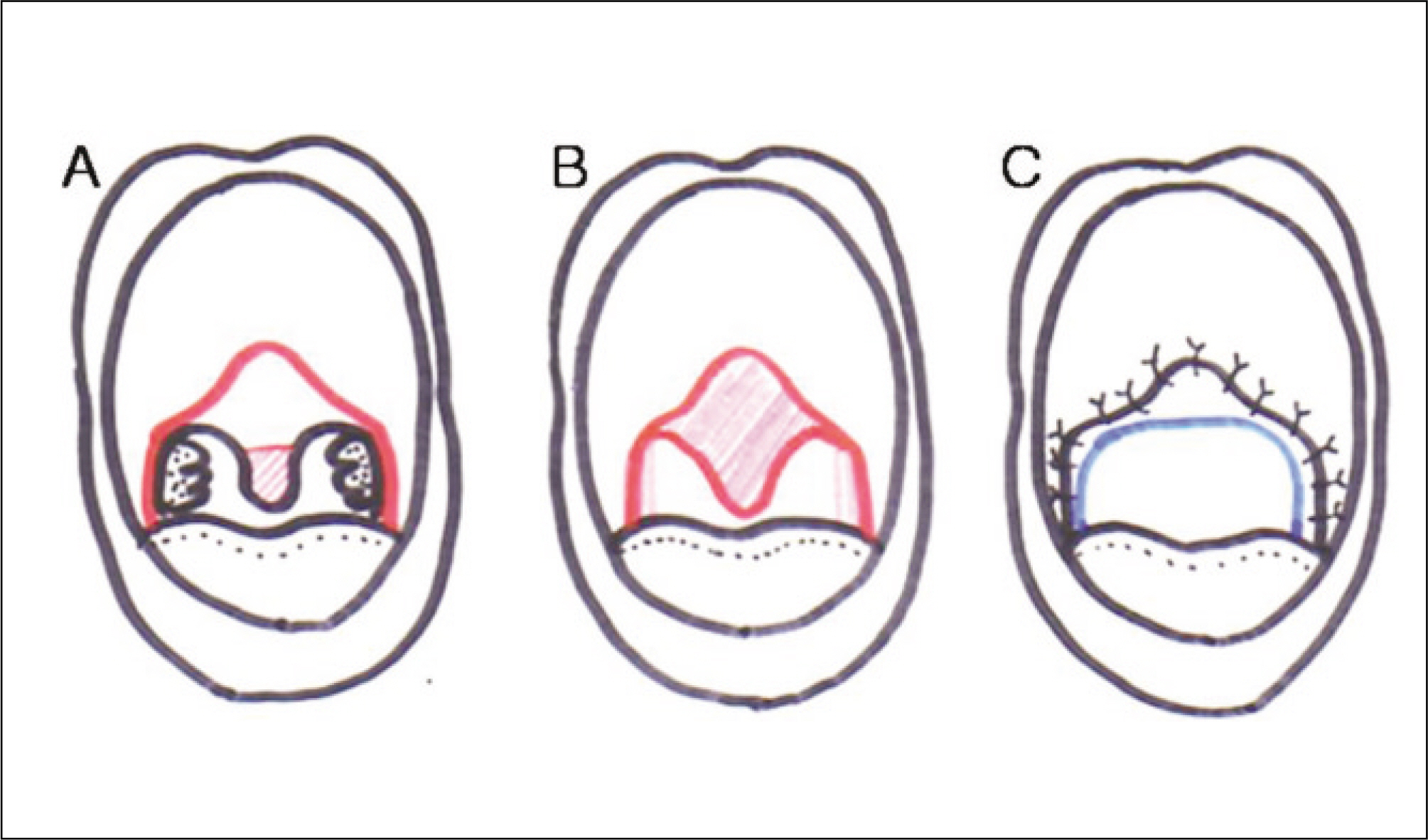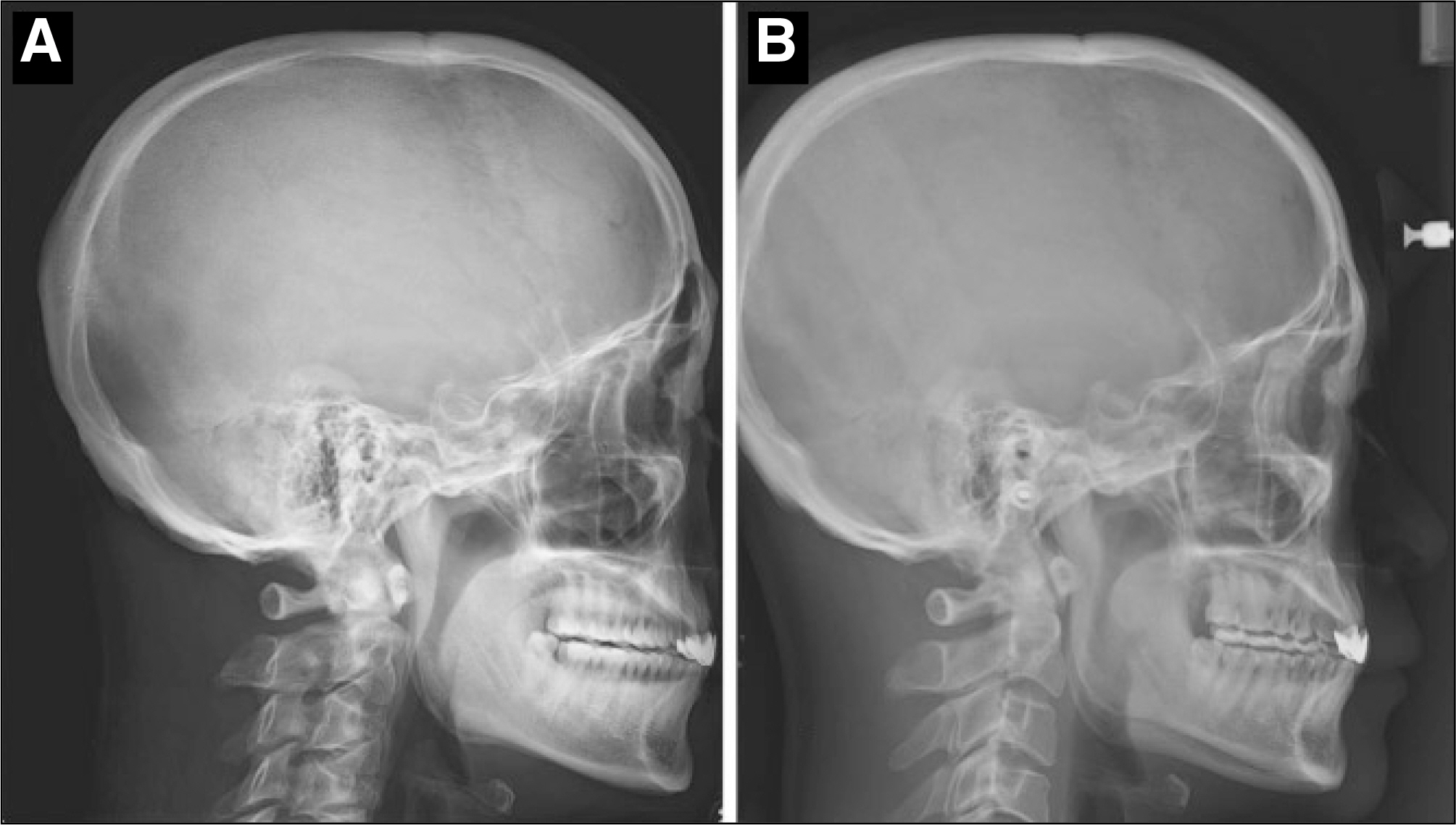J Korean Assoc Oral Maxillofac Surg.
2011 Feb;37(1):81-85. 10.5125/jkaoms.2011.37.1.81.
The treatment of obstructive sleep apnea patient using extended uvulopalatal flap: a case report
- Affiliations
-
- 1Department of Oral and Maxillofacial Surgery, School of Dentistry, Seoul National University, Seoul, Korea. jinychoi@snu.ac.kr
- KMID: 2189812
- DOI: http://doi.org/10.5125/jkaoms.2011.37.1.81
Abstract
- The uvulopalatal flap (UPF) technique is a modification of uvulopalatopharyngoplasty (UPPP) for the surgical treatment of obstructive sleep apnea. In the UPF technique, an uvulopalatal flap is fabricated and sutured to the residual mucosa of the soft palate to expand the antero-posterior dimensions of the oropharyngeal inlet. In the extended uvulopalatal flap (EUPF) technique, an incision at the tonsillar fossa is added to the classical UPF technique followed by the removal of mucosa and submucosal adipose tissue for additional expansion of the lateral dimension. The EUPF technique is more conservative and reversible than UPPP. Therefore, complications, such as velopharyngeal insufficiency, dysphagia, dryness, nasopharyngeal stenosis and postoperative pain, are reduced. In the following case report, the patient was diagnosed with obstructive sleep apnea and treated with the EUPF technique. The patient's total respiratory disturbance events per hour (RDI) was decreased to 15.4, the O2 saturation during the sleep was increased, and the excessive daytime sleepiness had disappeared after the surgery without complications. The authors report this case with a review of the relevant literature.
Keyword
MeSH Terms
Figure
Reference
-
References
1. Won CH, Li KK, Guilleminault C. Surgical treatment of obstructive sleep apnea: upper airway and maxillomandibular surgery. Proc Am Thorac Soc. 2008; 5:193–9.
Article2. Cho KS. Surgical management for obstructive sleep apnea. J Clin Otolaryngol Head Neck Surg. 2008; 19:168–76.
Article3. Rhee CS, Han DH. Surgical management of sleep-disordered breathing. Tuberc Respir Dis. 2009; 66:417–30.
Article4. Young T, Palta M, Dempsey J, Skatrud J, Weber S, Badr S. The occurrence of sleep-disordered breathing among middle-aged adults. N Engl J Med. 1993; 328:1230–5.
Article5. Huang SG, Li QY. Sleep Respiratory Disorder Study Group Respiratory Disease Branch Shanghai Medical Association. Prevalence of obstructive sleep apnea-hypopnea syndrome in Chinese adults aged over 30 yr in Shanghai. Zhonghua Jie He He Hu Xi Za Zhi. 2003; 26:268–72.6. Grote L, Hedner J, Grunstein R, Kraiczi H. Therapy with nCPAP: incomplete elimination of sleep related breathing disorder. Eur Respir J. 2000; 16:921–7.
Article7. Fujita S, Conway W, Zorick F, Roth T. Surgical correction of anatomic azbnormalities in obstructive sleep apnea syndrome: uvulopalatopharyngoplasty. Otolaryngol Head Neck Surg. 1981; 89:923–34.8. Walker-Engstro¨m ML, Tegelberg A, Wilhelmsson B, Ringqvist I. 4-year follow-up of treatment with dental appliance or uvulopalatopharyngoplasty in patients with obstructive sleep apnea: a randomized study. Chest. 2002; 121:739–46.9. Lee YK, Myung H, Hwang SJ, Seo BM, Lee JH, Choung PH, et al. Clinical study of surgical treatments for snoring and obstructive sleep apnea. J Korean Assoc Oral Maxillofac Surg. 2008; 34:435–44.10. Fairbanks DN. Uvulopalatopharyngoplasty complications and avoidance strategies. Otolaryngol Head Neck Surg. 1990; 102:239–45.
Article11. Haavisto L, Suonpa¨a¨ J. Complications of uvulopalatopharyngoplasty. Clin Otolaryngol Allied Sci. 1994; 19:243–7.
Article12. Li HY, Chen NH, Shu YH, Wang PC. Changes in quality of life and respiratory disturbance after extended uvulopalatal flap surgery in patients with obstructive sleep apnea. Arch Otolaryngol Head Neck Surg. 2004; 130:195–200.
Article13. Powell N, Riley R, Guilleminault C, Troell R. A reversible uvulopalatal flap for snoring and sleep apnea syndrome. Sleep. 1996; 19:593–9.
Article14. Li HY, Li KK, Chen NH, Wang PC. Modified uvulopalatopharyngoplasty: the extended uvulopalatal flap. Am J Otolaryngol. 2003; 24:311–6.
Article15. Johns MW. A new method for measuring daytime sleepiness: the Epworth sleepiness scale. Sleep. 1991; 14:540–5.
Article16. Friedman M, Ibrahim H, Joseph NJ. Staging of obstructive sleep apnea/hypopnea syndrome: a guide to appropriate treatment. Laryngoscope. 2004; 114:454–9.
Article17. Kim JH. Sleep apnea. Korean Society of Otorhinolayngology-Head and Neck Surgery. Otorhinolaryngology-Head and Neck Surgery. 1st ed.Seoul: Ilchokak;2002. p. 1103–14.18. Li HY, Li KK, Chen NH, Wang CJ, Liao YF, Wang PC. Three-dimensional computed tomography and polysomnography findings after extended uvulopalatal flap surgery for obstructive sleep apnea. Am J Otolaryngol. 2005; 26:7–11.
Article19. Kim SW. Eun YG. Surgical therapy for obstructive sleep apnea. J Clin Otolaryngol Head Neck Surg. 2005; 16:193–206.
- Full Text Links
- Actions
-
Cited
- CITED
-
- Close
- Share
- Similar articles
-
- The Outcome of Uvulopalatal Flap in Obstructive Sleep Apnea Syndrome Patients
- Treatment of Snoring and the Change of Surgical Treatment
- A Case of REM-Dependent Obstructive Sleep Apnea Syndrome
- A Case of Huge Lingual Tonsillar Hypertrophy Causing Obstructive Sleep Apnea in Adult
- Pathogenesis of Obstructive Sleep Apnea




